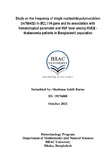| dc.contributor.advisor | Hossain, M. Mahboob | |
| dc.contributor.advisor | Mannoor, Md. Kaiissar | |
| dc.contributor.author | Barno, Shadman Sakib | |
| dc.date.accessioned | 2022-01-13T08:12:01Z | |
| dc.date.available | 2022-01-13T08:12:01Z | |
| dc.date.copyright | 2021 | |
| dc.date.issued | 2021-10 | |
| dc.identifier.other | ID 19176008 | |
| dc.identifier.uri | http://hdl.handle.net/10361/15913 | |
| dc.description | This thesis report is submitted in partial fulfillment of the requirement for the degree of Master of Science in Biotechnology, 2021. | en_US |
| dc.description | Catalogued from PDF version of thesis. | |
| dc.description | Includes bibliographical references (pages 43-46). | |
| dc.description.abstract | Background: Thalassemia is a genetic disorder that causes malformed globin chains in hemoglobin and is the most prevalent blood disorder worldwide with high incidence rates even in Bangladesh. When β-thalassemia is inherited together with a hemoglobin E allele, the resulting condition HbE/β-thalassemia is sometimes characterized by a severe, transfusion-dependent thalassemia major. The aim of this study was to find the frequency of single nucleotide polymorphism (SNP) rs766432 in the BCL11A gene and its association with hematological parameters and HbF production among patients with HbE/β-thalassemia in Bangladesh's population.
Methods: A total of 63 HbE/ß-thalassemia patients from the Thalassemia Samity Hospital, Dhaka participated in this study, with the full consent of all parties involved. Complete Blood Count (CBC) and hemoglobin electrophoresis were performed to determine hematological parameters and hemoglobin fractions respectively. SNP rs766432 frequency was determined through Sanger Sequencing followed by High Resolution Melt Curve Analysis based on Real-Time PCR. Graphpad Prism version 7 was used to carry out statistical analysis.
Results: For the HbE/ß-thalassemia patients, the frequency of rs766432 in BCL11A was found to be 75% homozygous genotype AA, 25% heterozygous genotype CA. In healthy individuals on the other hand, 74% homozygous major allele AA and 26% heterozygous minor allele CA was observed. However, no statistically significant differences were found in the mean±SD of hemoglobin indices for the CA genotype and AA genotypes. In addition, neither the age at first blood transfusion nor the transfusion interval was significantly higher in patients with the rs766432 polymorphism in comparison to those without.
Conclusion: This study found SNP rs766432 to have similar frequency among healthy individuals and HbE/β-thalassemia patients in Bangladesh. However, rs766432 SNP in BCL11A gene showed no correlation with either the HbF levels or clinical presentation of HbE/β-thalassemia patients in the study population. | en_US |
| dc.description.statementofresponsibility | Shadman Sakib Barno | |
| dc.format.extent | 46 pages | |
| dc.language.iso | en | en_US |
| dc.publisher | Brac University | en_US |
| dc.rights | Brac University theses are protected by copyright. They may be viewed from this source for any purpose, but reproduction or distribution in any format is prohibited without written permission. | |
| dc.subject | HbE/ß-Thalassemia | en_US |
| dc.subject | BCL11A gene | en_US |
| dc.subject | SNP | en_US |
| dc.subject | Fetal hemoglobin | en_US |
| dc.subject.lcsh | Thalassemia | |
| dc.title | Study on the frequency of single nucleotide polymorphism (rs766432) in BCL11A gene and its association with hematological parameter and HbF level among HbE/β -thalassemia patients in Bangladeshi population | en_US |
| dc.type | Thesis | en_US |
| dc.contributor.department | Department of Mathematics and Natural Sciences, Brac University | |
| dc.description.degree | M. Biotechnology | |

